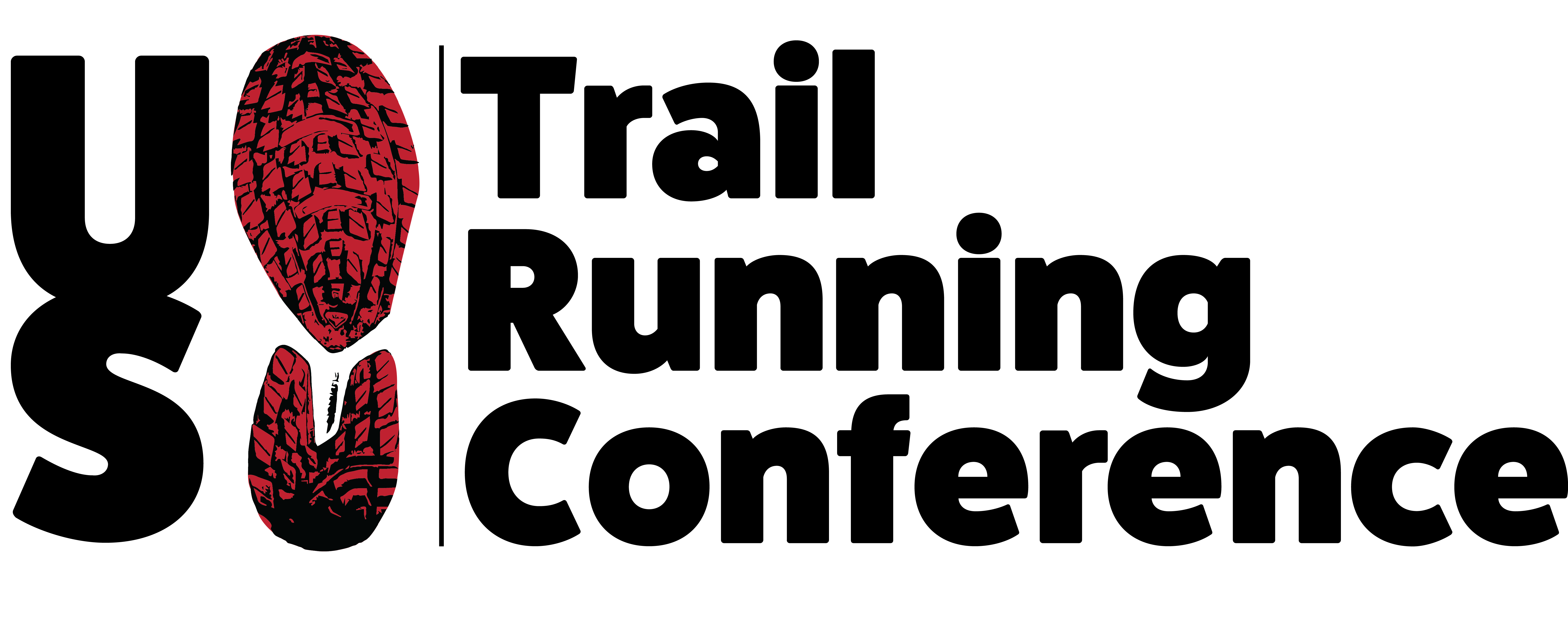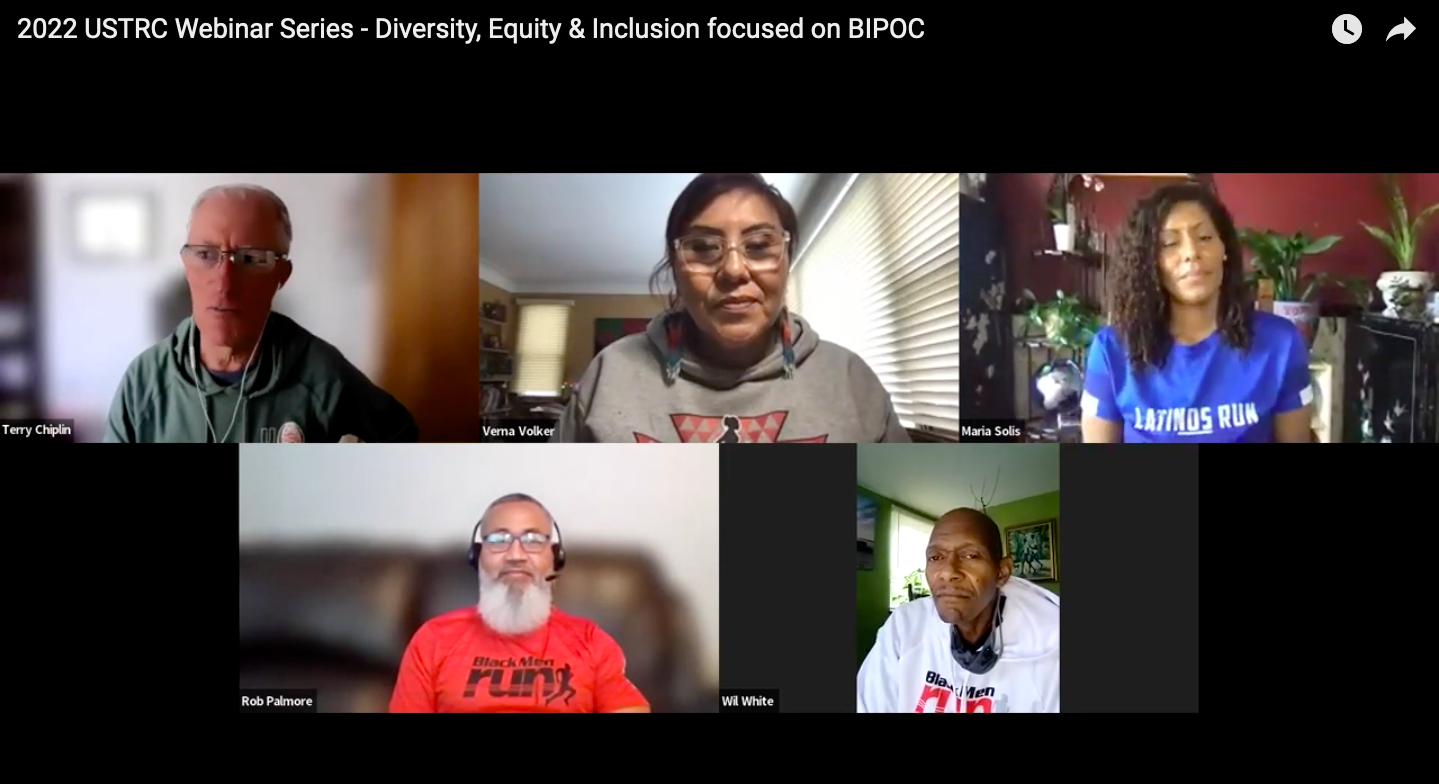Effective advice and actionable steps to enable race directors to reach out and connect with communities of color
The second webinar in a seven-webinar series produced by the US Trail Running Conference and presented by Marathon Printing, the leading producer of custom printed items for endurance sports, was live on Thursday, February 24. The session subject was: Diversity and Inclusion, focused on BIPOC, and was sponsored by Salomon. The webinar series is held in partnership with the American Trail Running Association.
This webinar’s content was focused on guidelines and actions that race directors and event organizers can follow to enable them to connect with their local communities of color with the aim of encouraging them to participate in race events and result in increased diversity for events. Panelists were Verna Volker, Founder, Native Women Running, Maria Solis, Founder, Latinos Run and Latinas Run, Will White & Rob Palmore, Trail Ambassadors with Black Men Run.
The session content started with covering land acknowledgement, a subject that some race directors have expressed concern over how to include within events. Volker noted that she “has noticed an increase in land acknowledgement in trail and ultra races….it is a wonderful thing, and I encourage people to visit the Native Governance Center website where you can learn how to acknowledge the land…. Our land, it’s stolen land, and vital and key, while at the same time be careful how you do it, and that your land acknowledgment goes beyond what you say. It’s important to also consider how you are going to support that community…it’s one of the key things with land acknowledgement.”
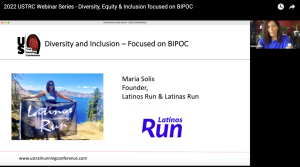 Solis shared that we “need to make sure our relationships are really authentic, really committed to our community, and helping to embrace our community, and also prepared to change the face of running….it’s not about checking a box, it’s about truly being authentic, and acknowledging that this comes with accountability.” Palmore added that “working with brands and partners it’s important that we are not just a check in the box, they need to fully understand what our mission is and what we strive to accomplish. Chiplin also disclosed that session sponsor Salomon not only sponsored this webinar session, they also have a requirement that the races that they sponsor and support also have DEI training, a good example of creating an authentic relationship that supports diversity within races and communities of color.
Solis shared that we “need to make sure our relationships are really authentic, really committed to our community, and helping to embrace our community, and also prepared to change the face of running….it’s not about checking a box, it’s about truly being authentic, and acknowledging that this comes with accountability.” Palmore added that “working with brands and partners it’s important that we are not just a check in the box, they need to fully understand what our mission is and what we strive to accomplish. Chiplin also disclosed that session sponsor Salomon not only sponsored this webinar session, they also have a requirement that the races that they sponsor and support also have DEI training, a good example of creating an authentic relationship that supports diversity within races and communities of color.
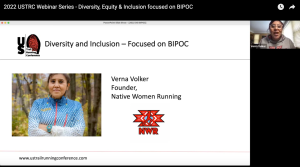 Moving on to the importance of being able to listen and learn, Volker commented that “she is often asked what can we do for our native community, or people of color…it’s really on you to listen and learn, and you do the research….with Native Women Running, I am the founder, however I have a community of women that are behind me. This is so key for our work as BIPOC runners.” White further added that listening didn’t just mean focusing on your ears… “I always take the opportunity at different races to be watching and reading….this is a two way street, so that while we want potential partners to listen to what we have to say, and then in order for us to be able to work with them, we need to be able to listen and understand what makes them tick, so we know that those things are going to be the things that make us gel with them.”
Moving on to the importance of being able to listen and learn, Volker commented that “she is often asked what can we do for our native community, or people of color…it’s really on you to listen and learn, and you do the research….with Native Women Running, I am the founder, however I have a community of women that are behind me. This is so key for our work as BIPOC runners.” White further added that listening didn’t just mean focusing on your ears… “I always take the opportunity at different races to be watching and reading….this is a two way street, so that while we want potential partners to listen to what we have to say, and then in order for us to be able to work with them, we need to be able to listen and understand what makes them tick, so we know that those things are going to be the things that make us gel with them.”
The next item covered was co-hosting an event with a local community or chapter. Solis commented that she has co-hosted many events around the country, and she “reaches out to local organizations or running groups that are different from Latinos Run….our community can be quite diverse, and when we all come together it’s not just the Latino community, it’s our shared love of running that brings us together whether that’s an indigenous community, or the guys from Black Men Run that come with us to a lot of events. I am co-hosting literally every week – it is very important as it not only helps to grow the Latino community, it also teaches people about connecting with the Latino community….in some cases this may be the first interaction they have had with welcoming Latinos, and lets people know that we are here.”
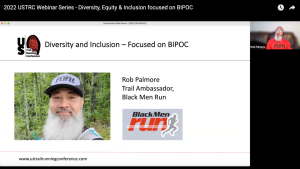 Palmore added comments from a Black Men Run perspective: “Not trying to be captain obvious here, Black Men Run is not just about black men running; our foundational reasons for being are based around health, and those are the conversations that we try and trigger when we work with other running communities.”
Palmore added comments from a Black Men Run perspective: “Not trying to be captain obvious here, Black Men Run is not just about black men running; our foundational reasons for being are based around health, and those are the conversations that we try and trigger when we work with other running communities.”
Content then turned to race directors providing local runners of color with guaranteed entries into a race that would lead to other runners of color to enter that same race. Palmore Commented, “Most race directors are aware of the run clubs or run organizations in the area where they put on the races, and this would be an ideal opportunity to extend an invitation for maybe a couple of folks from an organization, especially if that organization has ambassadors and by doing so…we know as runners that like to race that word of mouth can go a long way. As an ambassador I do an extensive data dump to all my followers when I take part in a race.”
Volker added, “I tell people that BIPOC runners, runners of color, we want to be ambassadors. One of the things that I have been working on is creating teams around races, so we will be having our first team in 2 weeks at Antelope Canyon. There are native women runners all over Canada and the US, and I can find someone who lives in that area – they not only represent themselves, they represent native women running, and that’s really key with representation. When people see that they are like, wow, I see people that look like me, and that is motivating so that native runners can feel like they belong at these races.”
Solis shared that “the reason I started the club was being at races and going up to people and asking them about other groups, and that word of mouth element is very important in our community. We don’t usually don’t have access to information about races. A lot of times when an organization puts on a race they don’t target the Latino community – members of the Latino community may not speak English, and so don’t get to see targeted advertising for that race. When ambassadors have an opportunity to benefit from a discounted entry or even free entries for a race, they go back to the community and say, hey, let’s do a race meet up like Verna said. If we can’t do a group run meet up every week, we can do a race meet up. With ambassadors around the country being far away from each other, a race meet up is a great way to connect…Discounted entries or free entries are really important and it helps us drive our community to those race organizers.” White added that he has noticed “races start to follow me on social media because of certain hashtags that I like to use….I have worked with a Latino based group in New York City, and also know some race directors in that area as well.”
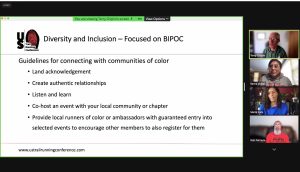 A participant’s question about reaching out to a BIPOC running group in Charleston, South Carolina, prompted Palmore to share that each Black Men Run chapter has a Facebook page that lists Black Men Run, followed by the city name. Once you search and find a group, you can request to join that group, and then get connected. Solis also shared that she would love to have an active chapter in Charleston as well!
A participant’s question about reaching out to a BIPOC running group in Charleston, South Carolina, prompted Palmore to share that each Black Men Run chapter has a Facebook page that lists Black Men Run, followed by the city name. Once you search and find a group, you can request to join that group, and then get connected. Solis also shared that she would love to have an active chapter in Charleston as well!
Another participant asked the panel’s thoughts on whether it was helpful to route a race through communities of color. Solis commented that “when she first started running the NYC marathon that runs through the five boroughs in New York, going from Staten Island to Manhattan, and you get to see what the different boroughs are like. You get to Harlem, that is a predominantly black neighborhood, and back in the day, there was nobody out there, and it was very discouraging. Then different black and ethnic groups started popping up, and now it’s the hypest place to be. You get to mile 20 in the Bronx, and what wakes you up is the salsa music. When you run through a community you’re not used to, it educates people, and introduces them to a community and other people they don’t know. I have seen sneaker brands get engaged, with adidas investing in renovating a track in Harlem as a result.”
Palmore added that it is important for race directors to connect with businesses close to a planned race route and explore the possibility of having them support your race event, finding ways to tie your local community into a race event.
Other actionable items included inviting a local community of color or chapter to have a tent or table setup, either pre or post event; donating to a local chapter or organization to help fund programs and services that support the BIPOC community; making long-term commitments, not just a one time assistance; connecting with high school cross country and track teams that often have runners of color; considering the role of unconscious bias and that the impact of not seeing anyone like me isn’t inviting; connecting with and inviting communities of color to participate as volunteers on course; sharing success stories like those from Vacation Races and Dirtbag Runners; the importance of making sure to accurately trail conditions and gear requirements who is not used to your local terrain and conditions; consider BIPOC communities for board or senior positions in your organization.
The webinar closed with comments from each panelist on appropriate and respectful use of imagery of BIPOC runners within the sport. Volker commented that “people will often look at us as in the past, and that Native people don’t exist, so it’s really important to know that Native people are 100% in existence….its also important to do your research and connect with the Native peoples in your area.”
Palmore added, “If I see someone out there that I can relate to culturally then it just makes me feel that much more comfortable. That is not just in advertising, it’s also your race crew, endless opportunities….also remember that shape is important as well, we come in all different shapes too. To attract newer runners include all the folks that might not exist in your current messaging.”
Solis commented that “I always say that you emulate what you see, and it’s so important for our communities to see people that look like us at their races, and this impacts more generations to come out and participate.”
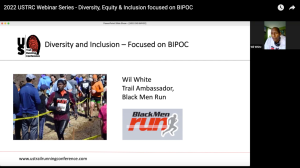 In closing, White added, “my picture was actually used for a race that I had signed up for in a promo for the race, and I hadn’t even run the race yet. They had pulled my picture from one of my social media feeds – it would have been good for them to reach out to me. I thought it was a little rude that they thought it was ok to use my picture to help promote their race, without connecting with me. I enjoyed the race, but that was an interesting thing to happen.”
In closing, White added, “my picture was actually used for a race that I had signed up for in a promo for the race, and I hadn’t even run the race yet. They had pulled my picture from one of my social media feeds – it would have been good for them to reach out to me. I thought it was a little rude that they thought it was ok to use my picture to help promote their race, without connecting with me. I enjoyed the race, but that was an interesting thing to happen.”
Each webinar is presented by industry leaders in their respective fields, and offers information that can boost a race director’s knowledge and afford insight into innovative practices to implement at their events. Every participant receives a slide deck with step by step information that includes best practices from the expert presenters. There will also be an opportunity to follow up on deliverables in-person at the 2022 US Trail Running Conference to be held October 19-22, in Mukilteo, Washington.
Active at Altitude, organizers of the US Trail Running Conference and the webinar series, reported participants representing more than 18 states, as well as Canada, North Macedonia, Great Britain, and New Zealand.
More info:
For details on the US Trail Running Conference and the webinar series, go to https://ustrailrunningconference.com/webinar-series/
Contact Event Director, Terry Chiplin for further information, terry@ustrailrunningconference.com, or 303-304-9159
#TrailConference #trailrunning #snocosports #snohomishcounty #PlayPNWSports #mukilteo #activeataltitude #atra #marathonprinting #TrailRunningIsForEveryBody
